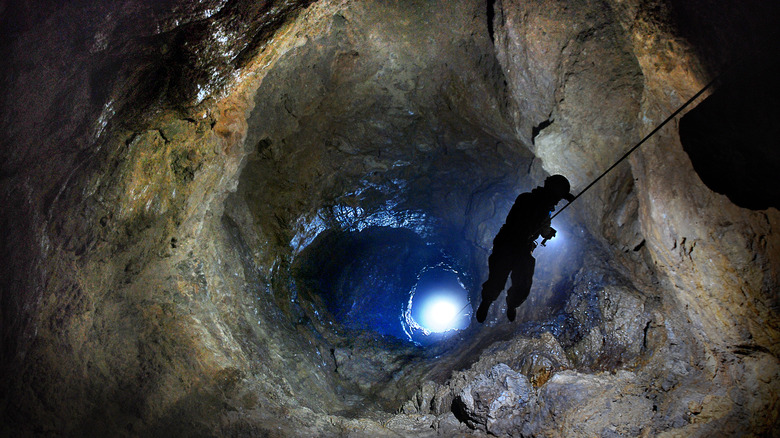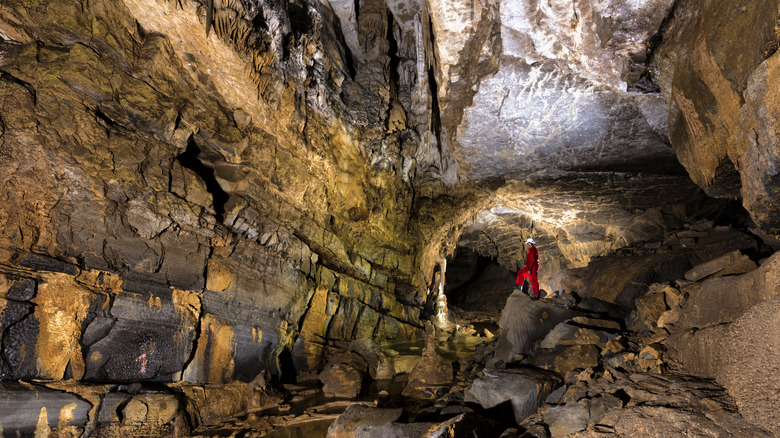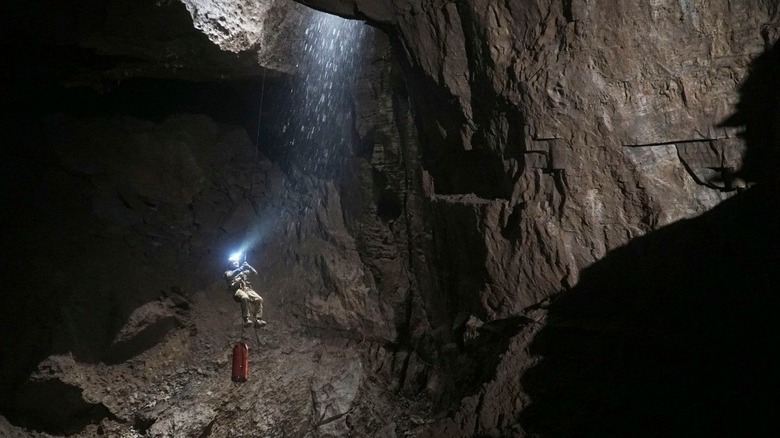This Cave Holds The Title As One Of The World's Most Dangerous Caves For A Reason
Correction 1/23/24: A previous version of this article stated that Abkhazia was a region of Georgia located on the Caspian Sea. Georgia borders the Black Sea, not the Caspian Sea.
In September 2018, a team of explorers at the bottom of the world's deepest cave had their breakfast interrupted by a dire warning. Two colleagues over 3,000 feet above spotted a flood pulse caused by heavy rainfall surging on its way to their friends far below. The team received the warning just in the nick of time, fighting their way up through the deluge in a race against the rising waters. Thankfully, no one was injured or killed, but it was a stark warning of the dangers faced by those drawn to the planet's deepest reaches.
The incident occurred in Veryovkina Cave, located high in the mountains of the disputed region of Abkhazia in Georgia on the Black Sea. A few months earlier, Veryovkina took the record for the world's deepest cave from its neighbor, Krubera, when an expedition reached a phenomenal depth of 7,257 feet. The two caves were discovered in the '60s but remained largely unexplored until the '80s, and Krubera was known as the "Everest of Caves" until Veryovkina surpassed it. In 2023, the depth was extended further when a Russian caving club used an underwater drone to reach an incredible 7,293 feet — the equivalent of nearly six Empire State Buildings stacked on top of one another.
As the Veryovkina near-drowning proved, tackling caves of this magnitude is a serious business and the perils are many. The 2018 team was fortunate to escape with their lives, but others haven't been so lucky.
Why is exploring caves like Veryovkina so dangerous?
Caves and karst systems are a relative mystery compared to mountains, although the challenge of exploring them requires some similar skills. Whereas mountains are big rocky things visible from many miles around, caves don't seize the popular imagination quite as much because they are hidden beneath our feet. Caving is also a relatively new activity compared to mountaineering, which became a popular sport during the mid-1800s in the golden age of alpinism. By contrast, caving took off in the States during the 1940s, and a depth of 3,280 feet (1,000 meters) was only first achieved by French explorers in 1956.
The logistics of exploring a cave as deep as Veryovkina are daunting. The secrets of such an abyss only reveal themselves over time and multiple expeditions because a cave complex like Veryovkina is a true labyrinth. The initial venture into Veryovkina only achieved a depth of around 377 feet. The rest was achieved over decades, during which explorers also charted around 10 miles (57,414 feet) of branching passageways, shafts, squeezes, subterranean lakes, and sumps. Expeditions into its farthest reaches involve teams of cavers using base camps as temporary homes as they spend many days underground pushing farther into the deepest recesses of the Earth. In short, it's not the kind of place you want to get lost or tackle without the proper experience and equipment. But one intrepid tourist took on the challenge without heeding the warnings.
A tragic death in Veryovkina Cave
Veryovkina Cave is so dangerous that only the foolhardy would explore it on their own, but that is exactly what outdoor enthusiast Sergei Kozeev did in 2020 when he made a solo descent. No one saw him again until around nine months after he was reported missing when cavers discovered his body dangling from a rope more than a mile into the cave. Evgeny Snetkov, a member of the Board of the Union of Cavers, called Kozeev's fatal actions a gross violation of safety regulations. The deceased's cause of death was most likely hypothermia, and retrieving his body from such depths also potentially put others in harm's way. It took 100 volunteer cavers to mount a recovery operation which involved the grisly task of dismembering Kozeev's corpse so it could be transported to the surface.
The sad case of Kozeev's demise and hazardous retrieval further highlights the dangers faced by explorers in Veryovkina Cave. Aside from the technical and logistical challenges of spending days in the cold, wet, and dark, those planning a spelunking expedition also face hazards like falls, cave-ins, hypothermia, drowning, or simply getting lost. Veryovkina currently holds the world record for the deepest, but the race may not be over yet. There is still a chance that further reaches will be obtained or a new challenger will be discovered, luring explorers ever deeper. To paraphrase the ill-fated mountaineer, George Mallory, the adventurous will keep facing subterranean dangers in pursuit of new cave records because they are there.


